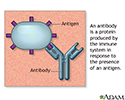Graft-versus-host disease
GVHD; Bone marrow transplant - graft-versus-host disease; Stem cell transplant - graft-versus-host disease; Allogeneic transplant - GVHD
Graft-versus-host disease (GVHD) is a potentially life-threatening complication that can occur after certain stem cell or bone marrow transplants.
Causes
GVHD may occur after a bone marrow or stem cell transplant in which someone receives bone marrow tissue or cells from a donor. This type of transplant is called allogeneic. The new, transplanted cells regard the recipient's body as foreign. When this happens, the cells attack the recipient's body.
GVHD does not occur when people receive their own cells. This type of transplant is called autologous.
Before a transplant, tissue and cells from possible donors are checked to see how closely they match the recipient. GVHD is less likely to occur, or symptoms will be milder, when the match is close. The chance of GVHD is:
- Around 35% to 45% when the donor and recipient are related
- Around 60% to 80% when the donor and recipient are not related
Symptoms
There are two types of GVHD: acute and chronic. Symptoms in both acute and chronic GVHD range from mild to severe.
Acute GVHD usually happens within days or as late as 6 months after a transplant. The immune system, skin, liver, and intestines are mainly affected. Common acute symptoms include:
- Abdominal pain or cramps, nausea, vomiting, and diarrhea
- Jaundice (yellow coloring of the skin or eyes) or other liver problems
- Skin rash, itching, redness on areas of the skin
- Increased risk for infections
Chronic GVHD usually starts more than 3 months after a transplant, and can last a lifetime. Chronic symptoms may include:
- Dry eyes, burning sensation, or vision changes
- Dry mouth, white patches inside the mouth, and sensitivity to spicy foods
- Fatigue, muscle weakness, and chronic pain
- Joint pain or stiffness
- Skin rash with raised, discolored areas, as well as skin tightening or thickening
- Shortness of breath due to lung damage
- Vaginal dryness
- Weight loss
- Reduced bile flow from the liver
- Brittle hair and premature graying
- Damage to sweat glands
- Cytopenia (decrease in number of mature blood cells)
- Pericarditis (inflammation in the membrane surrounding the heart; causes chest pain)
Exams and Tests
Several lab and imaging tests can be done to diagnose and monitor problems caused by GVHD. These may include:
- X-ray abdomen
- CT scan abdomen and CT chest
- Liver function tests
- PET scan
- MRI
- Capsule endoscopy
- Liver biopsy
A biopsy of the skin, mucous membranes in the mouth, may also help to confirm the diagnosis.
Treatment
After a transplant, the recipient usually takes medicines, such as prednisone (a steroid), which suppress the immune system. This helps reduce the chances (or severity) of GVHD.
You'll continue taking the medicines until your transplant health care provider thinks the risk for GVHD is low. Many of these medicines have side effects, including kidney and liver damage. You'll have regular tests to watch for these problems.
Outlook (Prognosis)
The outlook depends on the severity of GVHD. People who receive closely matched bone marrow tissue and cells usually do better.
Some cases of GVHD can damage the liver, lungs, digestive tract, or other body organs. There is also a risk for severe infections.
Many cases of acute or chronic GVHD can be treated successfully. But this doesn't guarantee that the transplant itself will succeed in treating the original disease.
When to Contact a Medical Professional
If you have had a bone marrow transplant, contact your transplant provider right away if you develop any symptoms of GVHD or other unusual symptoms.
References
Chao NJ, Keating A. Hematopoietic stem cell transplantation. In: Goldman L, Cooney KA, eds. Goldman-Cecil Medicine. 27th ed. Philadelphia, PA: Elsevier; 2024:chap 163.
Im A, Pavletic SZ. Hematopoietic stem cell transplantation. In: Niederhuber JE, Armitage JO, Kastan MB, Doroshow JH, Tepper JE, eds. Abeloff's Clinical Oncology. 6th ed. Philadelphia, PA: Elsevier; 2020:chap 28.
Riwes M, Ferrara JL, Reddy P, Magenau JM. Graft-versus-host disease and graft-versus-leukemia responses. In: Hoffman R, Benz EJ, Silberstein LE, et al, eds. Hematology: Basic Principles and Practice. 8th ed. Philadelphia, PA: Elsevier; 2023:chap 109.
Review Date: 6/17/2024

















